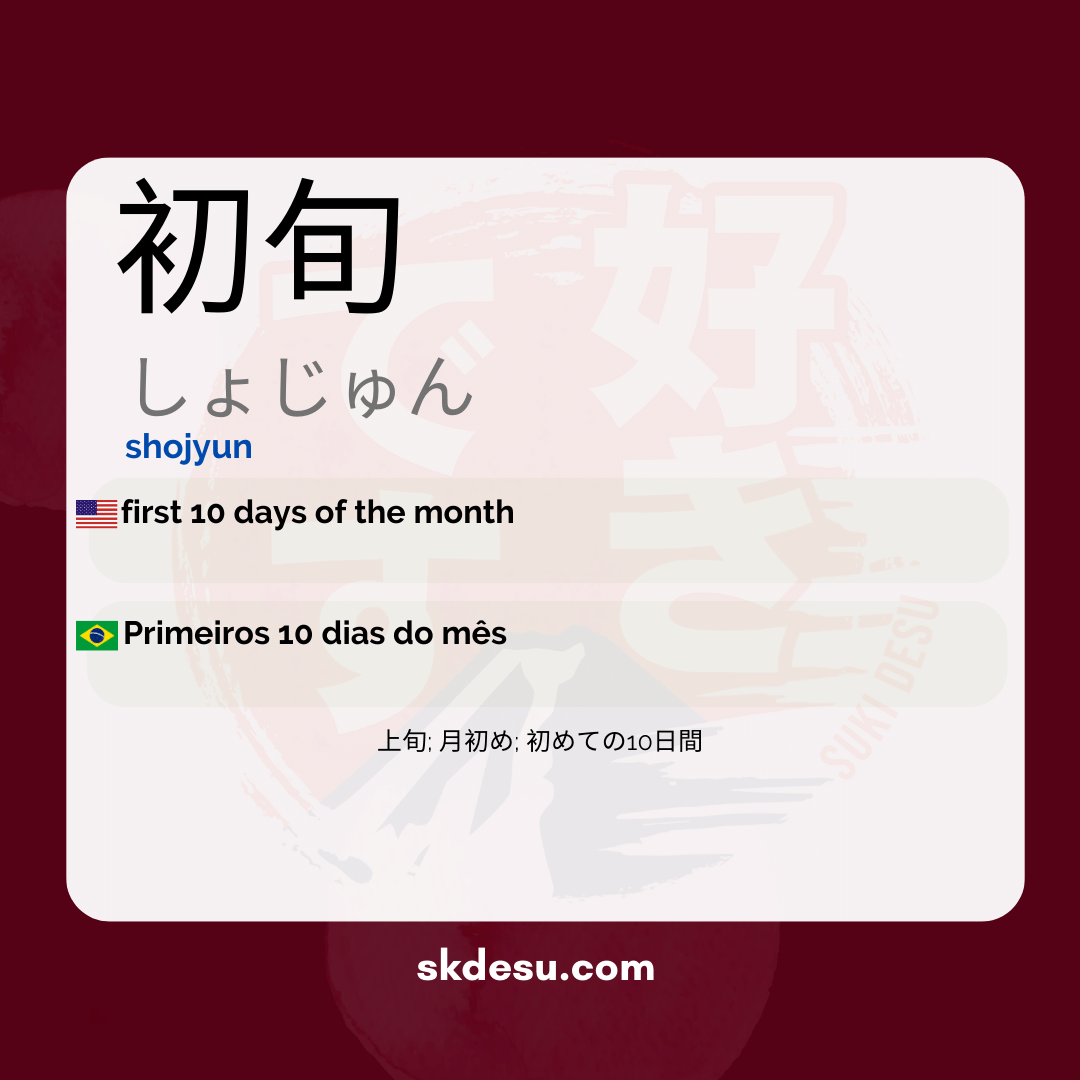Translation and Meaning of: 初旬 - shojyun
The Japanese word 初旬[しょじゅん] may seem simple at first glance, but it carries interesting nuances for those learning the language or interested in Japanese culture. In this article, we will explore its meaning, origin, and how it is used in everyday Japanese. Furthermore, we will understand why this expression is so relevant in contexts such as calendars, planning, and even in informal conversations.
If you have ever wondered how the Japanese divide the month or how they express specific periods, 初旬 is one of those words that helps organize time practically. Here, we will unveil its most common uses, curiosities, and even tips to memorize it easily. All this without complications, so you can apply this knowledge in your studies or trip to Japan.
The meaning and origin of 初旬
初旬, read as "shojun," refers to the first ten days of a month. The word is composed of two kanji: 初 (sho), meaning "beginning" or "first," and 旬 (jun), which can be translated as "period of ten days" or "decade." Together, they form an expression that clearly delineates the first part of the month in the Japanese calendar.
Although it is not an ancient word, its use is deeply rooted in the organization of time in Japan. Unlike Western cultures, which often divide the month into weeks, the Japanese also use this division into ten-day periods for business planning, seasonal events, and even in agriculture. This structure facilitates communication in formal and informal contexts.
How and when to use 初旬 in everyday life
初旬 often appears in schedules, work planning, and even in weather forecasts. For example, it's common to hear phrases like "今月初旬に会議があります" (Honnetsu shojun ni kaigi ga arimasu), which means "There is a meeting at the beginning of this month." Its usage is more formal than colloquial, but it still appears in everyday conversations when discussing deadlines or scheduled events.
It is worth noting that, although 初旬 is useful, the Japanese also use expressions like 上旬 (jōjun) for a similar meaning. However, 上旬 may be a bit broader, while 初旬 is more specific. If you are writing a professional email or marking an important date, using 初旬 conveys clarity and precision, avoiding ambiguities.
Tips for memorizing and curiosities about 初旬
An effective way to remember 初旬 is to associate it with events that happen at the beginning of the month, such as payments, holidays, or recurring appointments. Creating flashcards with practical examples also helps, especially if you are studying Japanese for business or travel. Another tip is to observe how the word appears in Japanese news or TV programs, as it is often used in real contexts.
An interesting fact is that, although 旬 can also refer to "seasonality" (as in 旬の食材 - seasonal ingredients), in the case of 初旬, the meaning is purely temporal. This duality of the kanji 旬 shows how the Japanese language utilizes characters to create multiple meanings depending on the context. Therefore, paying attention to individual kanjis can be a great help in learning.
Vocabulary
Expand your vocabulary with related words:
Synonyms and similar words
- 上旬 (joujun) - First third of the month.
- 月初め (tsuki hajime) - Beginning of the month; it usually refers to the first part of the month.
- 初めての10日間 (hajimete no tookakan) - The first ten days; it can refer to the beginning of a cycle or event.
Related words
Romaji: shojyun
Kana: しょじゅん
Type: noun
L: jlpt-n2
Translation / Meaning: First 10 days of the month
Meaning in English: first 10 days of the month
Definition: First 10 days of the month.
Quick Access
- Vocabulary
- Writing
- Sentences
How to Write in Japanese - (初旬) shojyun
See below a step-by-step guide on how to write the word by hand in Japanese. (初旬) shojyun:
Example Sentences - (初旬) shojyun
See below some example sentences:
Nenhum resultado encontrado.
Other Words of this Type: noun
See other words from our dictionary that are also: noun

